
table of contents
- Among shallow-rooters
- Among heart roots
- Among deep-rooters
- frequently asked Questions
Planting under trees is a particular challenge. For many plants, trees are a strong competition for roots, which makes underplanting impossible. But there are species that are perfect for this.
In a nutshell
- not every plant is suitable for underplanting trees
- most important factor, the tree's root system
- A distinction is made between shallow, deep and heart roots
- Underplanting of shallow roots is the most difficult
Among shallow-rooters
The roots of shallow roots run like a plate close to the surface of the earth, which makes it difficult to plant under trees. In order to plant even heavily rooted soil, a thick layer of mother earth on the tree grate helps.
Balkan cranesbill (Geranium macrorrhizum)

- Drought tolerant shade perennial
- plant in close proximity to the trunk
- varied foliage
- May-June clusters of violet, red, white or pink flowers
Bergenia (Bergenia)

- persistent, herbaceous, approx. 30 cm
- on the edge of the root disc
- great leaf decoration with autumn colors
- large showy inflorescences in spring
Bluestar (Scilla sibirica)

- between 10 and 20 cm
- tend to run wild
- Flowering period: February-April
- blue, cup-shaped grape blossoms
- sunny and partially shaded areas
Brown cranesbill (Geranium phaeum)

- upright, 50-75 cm high perennial
- dry, partially shaded locations
- on the north side of the tree grate
- Main flowering period: May-July
- small blackish-red flowers
Common ivy (Hedera helix)
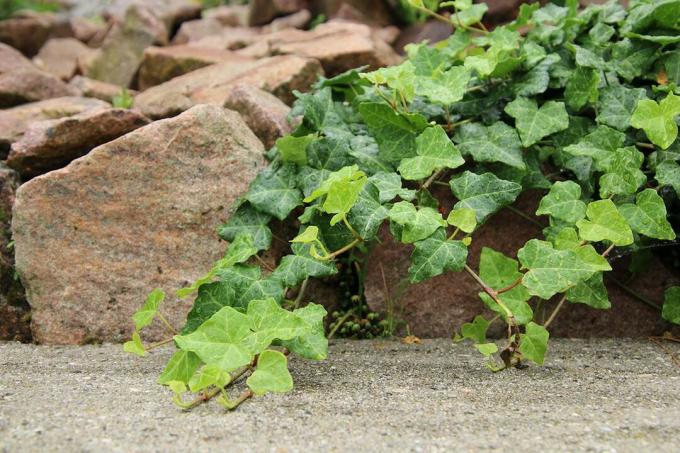
- at the edge of large tree grates
- spreads towards the trunk
- Settlement also on deeply rooted soil
- different leaf colors
Monkshood (aconite)
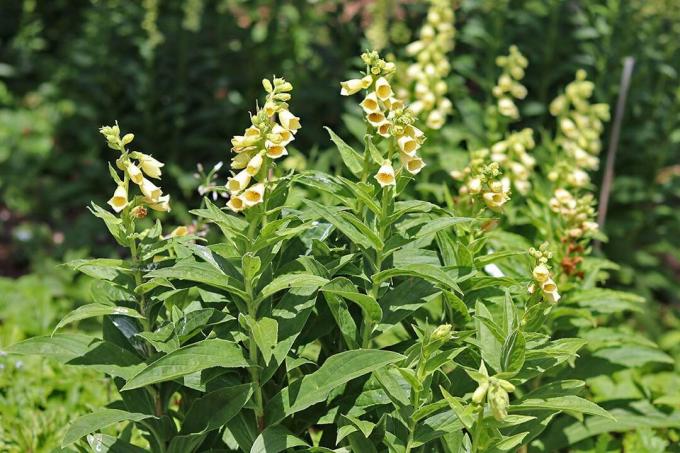
- clumpy perennial, upright, leafy flower stalks
- Height 90-100 cm
- purple-blue flowers from July-August
- partially shaded to shady place
Tip: The monkshood is highly poisonous and one of the most poisonous plants in Europe.
Elven flower (Epimedium)

- Carpet-forming ground cover, 15-30 cm
- suitable for all tree grates
- even under the widely spreading treetops
- green, heart-shaped leaves, golden yellow autumn colors
- April-May white, pink, red, yellow or purple flowers
Ferns

- also among pronounced shallow roots
- especially good under apple trees and conifers
- Partial shade to shade
- Heights of growth 30 to 80 cm
- varied leaf fronds in shape, color and size
Hosta
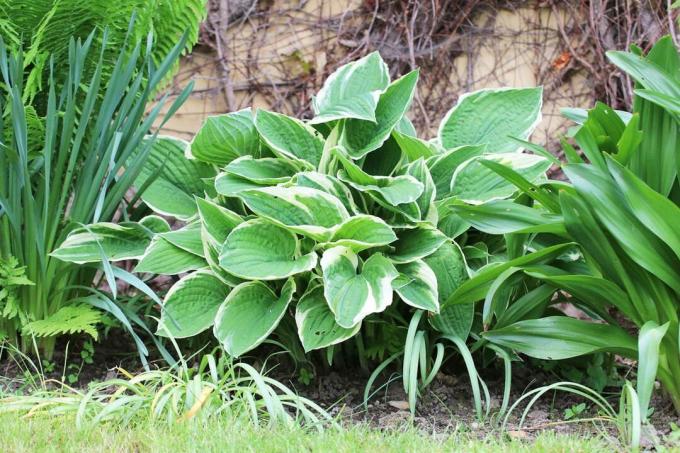
- Decorative leaf plants, 60-100 cm
- small, shady tree slices, outer edge area
- Water the root area of the plantain regularly
- June-August white to purple bell flowers
Golden strawberry / Waldsteinie (Waldsteinia geoides)

- robust, drought tolerant shade perennial
- Ground cover without runners
- Height 15-30 cm
- Planting near the trunk
- yellow flowers in April / May
Large star umbel (Astrantia major)
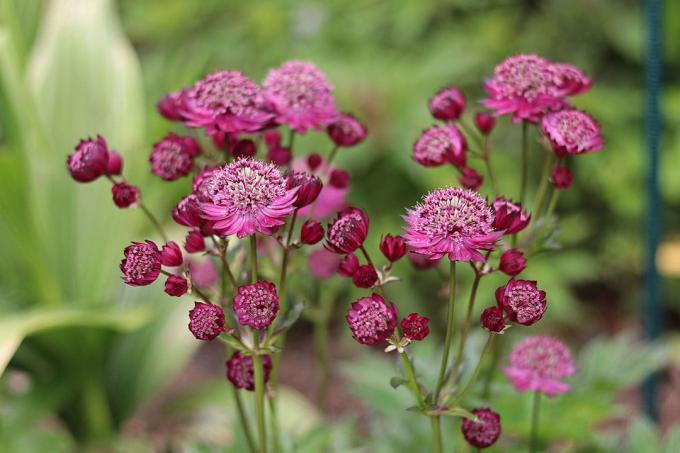
- bushy, clumpy, upright flower stalks, 40-50 cm
- white to pink flowers from June to August
- slightly damp locations
- on the outer edge of the root disc
Japanese ribbon grass (Hakonechloa macra 'Aureola')

- Shade grass for the winter garden
- Growth height of 20-40 cm
- Planting in partial shade
- yellow-green foliage, reddish shoots and autumn colors
- Panicle-like flowers from August to October
Caucasus forget-me-nots (Brunnera macrophylla)

- broadly bushy, basal leaf clusters
- Growth height 30-50 cm
- loose blue inflorescences
- blooms from April-May
- slightly sunny to shady areas
Lesser periwinkle (Vinca minor)

- ground covering perennial, 10-30 cm
- shady to sunny areas
- under linden trees, in the partial shade of conifers
- April-May, light blue to purple, rarely white flowers
- Before planting compost in the planting hole
Creeping Gunsel (Ajuga reptans)

- Ground cover, rapid expansion, up to 20 cm
- April-June long, dark purple inflorescences
- sunny to partially shaded areas
- very good under birch trees
Lungwort (Pulmonaria officinalis)

- Ground cover with purple or pink flowers, 25-30 cm
- flowers before the leaves of the trees shoot
- Partial shade and light shade
- perfect for underplanting deciduous trees
- around the tree optimally
Lily of the valley (Convallaria majalis)

- runners, 15-30 cm
- in the shade of trees B. Cherry trees
- blooms in May, depending on the weather
- white, bell-shaped flower clusters
Tip: Lilies of the valley are poisonous, as is the sap. Its leaves can easily be confused with those of wild garlic. Nevertheless, it is well suited for planting under trees.
Carnation root (Geum coccineum)

- upright, rhizome-forming, 20-30 cm
- Underplanting of larger tree grates
- outer edge of the tree grate
- May-July, orange-red cupped flowers
Purple bells (Heuchera)

- bushy, cushion-forming, 20-50 cm
- Underplant small, sunny tree slices
- decorative, colorful foliage
- May to August, white to pink panicles of flowers
Ray anemone (Anemone blanda)

- loose-grass, upright flower stalks, 5-15 cm
- Flowering: March to April
- white, pink or deep blue ray-flowers
- well under deciduous trees
White forest aster (Eurybia divaricata)

- Most shade-tolerant aster species, 40-60 cm
- bushy, short runners, moderate urge to train
- blooms from July-September
- white cup-like flowers
Among heart roots
Heart roots are a hybrid of deep and shallow roots and are much easier to underplant. They align their root system with the soil and grow deeper in dry locations and outward in moist locations.
Columbine (Aquilegia vulgaris)
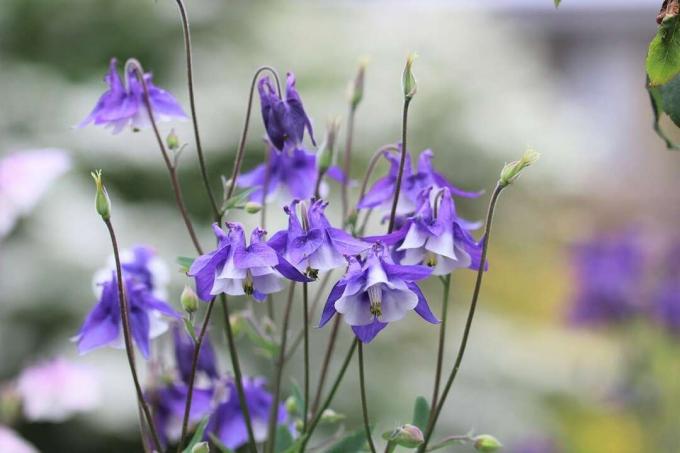
- herbaceous, perennial, 30-60 cm
- unusual flower shape, conspicuous spur
- blooms from May-June
- Underplant small, sunny tree slices
Alpine currant (Ribes alpinum)

- Compatible with shade, compact, upright shoots
- Growth height 100-200 cm
- yellow-green, racemose flowers from April-May
- Underplanting of deciduous trees e.g. B. Oak trees
Nasturtium (Tropaeolum)

- herbaceous, shoots up to 250 cm long
- good under fruit or Apple trees
- Edible leaves and flowers
- Flowering and harvesting May-October
- red, yellow or orange funnel-shaped flowers
Tip: Under the apple tree, the nasturtium can help against the apple leaf sucker.
Lavender (Lavandula angustifolia)
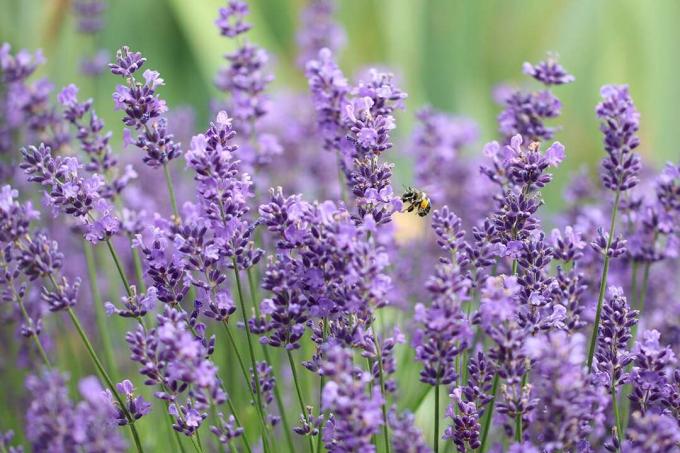
- Subshrub, up to 100 cm
- violet flowers with an intense fragrance
- suitable for underplanting the rock pear
- on sunny part of the tree slice
- Improve the planting area with sand
Tip: Other drought-tolerant herbs are also suitable for planting under trees.
Oregon grape (Mahonia aquifolium)

- shrub-like, compact, 80-120 cm
- can withstand root pressure well
- good as underplanting of rock pear
- in shady areas
- golden yellow, racemose flowers from April to May
Spindle bush (Euonymus)

- ground-covering small shrub or climbing plant
- expansive, upright, cushion-forming
- 20 cm high, shoots up to 500 cm long
- well under beeches
- white to greenish-yellow flowers from June to July
Waldaster (Aster divaricatus)

- delicate white forest asters
- quickly forms larger stocks
- partially shaded to shady areas
- Small star-shaped flowers from August to October
Among deep-rooters
Deep roots take root in the depths, the area of the tree disc remains largely open. There is no root competition for other plants, which makes a diverse planting under trees possible.
Balkan cranesbill (Geranium macrorrhizum)

- Drought tolerant, pillow-forming perennial
- Planting near the trunk
- in partial shade or shade
- Growth height 25-35 cm
- June-July, umbel-shaped, pale pink flowers
Floribunda rose 'Bonica (R) 82’®

- lush growth, often blooming, 60-80 cm
- large double pink flowers
- blooms from June to September
- easy to plant under fir trees
- Sun to partial shade
Blackberries (Rubus sect. Rubus)

- perennial herbaceous, hardy shrubs
- Flowering period: May-August
- Fruit ripening: August to September
- under linden, larch or fruit trees
- at some distance from the trunk
Finger bush(Potentilla fruticosa)

- expansive, bushy, upright
- Small shrub, 50 to 130 cm
- long flowering period from June to October
- pretty yellow or white flowers
- sunny areas under fir trees
Spring pea (Lathyrus vernus)

- bushy, upright, clumpy, 15-30 cm
- blooms from April-May
- purple-blue, rarely white or pink flowers
- in the light-rich edge area under deciduous trees
Spotted dead nettle (Lamium maculatum)

- creeping, forming runners, approx. 25 cm
- decorative green-white, heart-shaped leaves
- from June purple flowers
- on large, shady tree slices
Hazelwort (Asarum europaeum)

- creeping, flat, rhizome-forming, 3-15 cm
- smelling of pepper
- Flowers under the foliage
- March-April, red-brown, funnel-shaped flowers
- partially shaded areas z. B. under linden trees
Hydrangea

- shrub-like, broad, upright crowns
- Depending on the variety, up to 200 cm
- Flowering period: June-September
- in the edge area of the root disc
- light shade and partial shade, partly also full shade
- ideally under yew or thuja
Dog rose (Rosa canina)
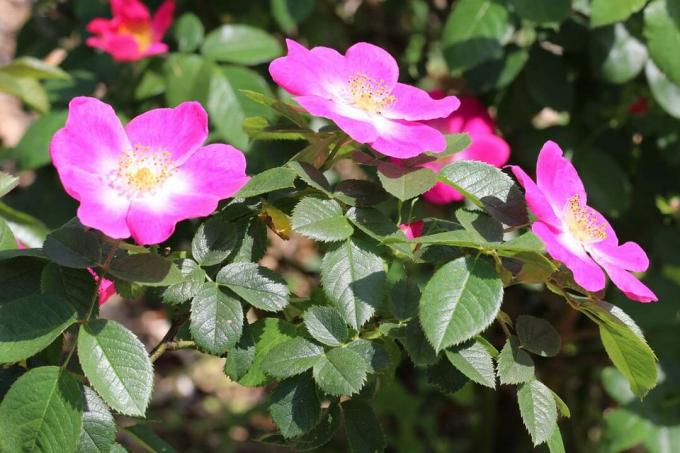
- Bush or spreading climber
- fast-growing, runners, 200-300 cm
- Underplanting of deciduous trees, e.g. B. Oak trees
- fragrant pink flowers in May / June, short-lived
Japanese forest grass (Hakonechloa macra)

- expansive, arched, 30-60 cm
- greenish, panicle-shaped flowers from August to October
- partially shaded area of the tree grate
- six to eight plants per square meter
Kaladie (Caladium)
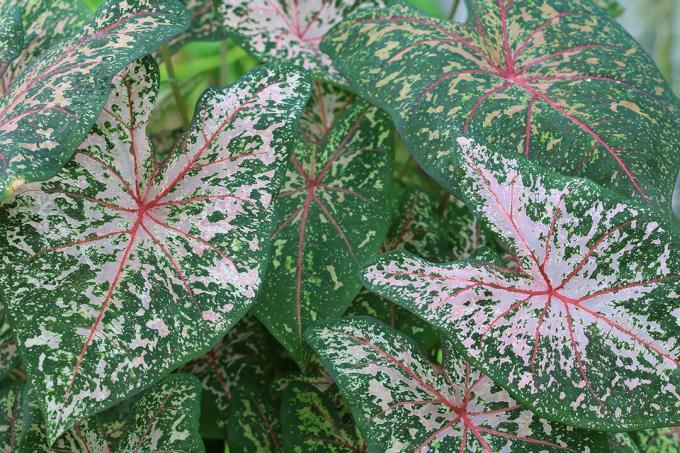
- upright, clump-forming ornamental leaf, 20-40 cm
- large variety of foliage colors
- white flowers from March-May
- plant around tree trunk, e.g. B. under oaks
tip: The tubers are not hardy. They have to be dug up in autumn and overwintered frost-free.
Carpet dogwood (Cornus canadensis)

- Runners-forming ground cover, 10-20 cm
- creamy white flowers in June
- bright red fruits after flowering
- well in partial shade under Fir trees
Tip: Planting under trees, how Firs usually have to be watered every now and then.
frequently asked Questions
In principle, trees can be planted under between spring and autumn. The ideal time is between late July and early September, when the trees are almost complete. This leaves more moisture in the soil for the new plantings.
Shallow roots are z. B. Birch, poplar, spruce, Douglas fir, willow, hornbeam and spruce. The deep-rooters include u. a. Yew, fir, oak, cherry, linden, apple and plum trees.
Yes, the walnut tree. Underplanting is hardly possible here, because the walnut cannot tolerate any competition from roots. In addition, the essential oils contained in their leaves would impair the growth of other plants or even make them impossible.



